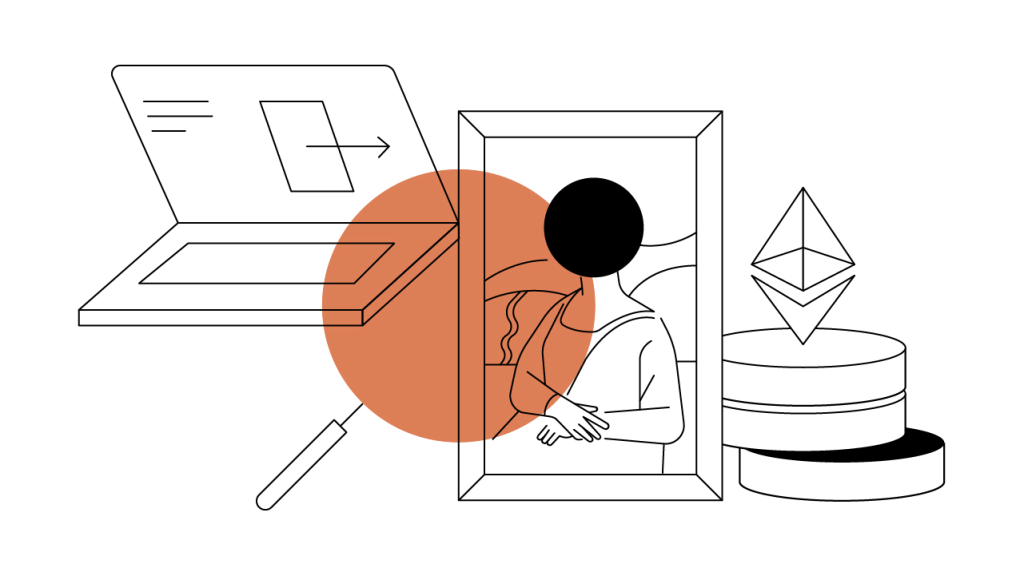Contents
NFTs and the Art Industry: A Cryptoart Revolution
The NFT art movement has sped from a sprint to a gallop, and the world is taking notice.

Summary
Cryptoart is digital art that lives on the blockchain in the form of non-fungible tokens (NFTs). This fast-emerging sector is disrupting the art industry for artists, dealers, and investors alike — and creating a far more accessible, equitable, and inclusive art market.
Digital Art Gives Rise to NFT Art
Before diving into the finer details of contemporary cryptoart, it’s helpful to take a brief look at the history of digital art prior to the emergence of . Digital art is one of the more popular subgenres of contemporary art, and has been around since the 1970s. It’s a catch-all term for a number of phenomena. Digital art may reference works created or enhanced with software, digitally rendered animations, or interactive art consumed through a digital device. There’s also “generative” digital art, which artists produce mostly by using algorithms.
Some digital artists are using blockchain technology itself as their medium — employing custom software and code, along with a slew of new to create their work. Once it’s on the blockchain, digital art falls into the realm of cryptoart. So what is cryptoart exactly? As with all things crypto, the vocabulary and definitions surrounding this art movement are dynamic and iterative, but there is a baseline distinction: Cryptoart is art on the blockchain — natively published as an NFT.
These rare digital artworks — sometimes called crypto-collectibles, NFT art, nifties, or cryptoart — are represented by unique and provably rare tokens. Because they are native to the blockchain, NFT artworks can be bought, sold, and owned with cryptographic security and veracity. Each is unique and the decentralized, open nature of blockchain technology allows for transparent proof of this.
The Explosion of Cryptoart and NFT Art
Before NFT art captured the zeitgeist, early projects like Monegraph in 2014 and Rare Pepe in 2016 allowed users to register collectibles on blockchain networks. In 2017, a new vehicle for digital art emerged with Ethereum’s introduction of the . Different from Ethereum’s E, this token standard enabled the creation of NFTs and springboarded the cryptoart movement into existence. 2017 saw the rise of CryptoPunks, , CurioCards, and Dada.nyc. All these projects made NFTs on Ethereum — paving the way for the NFT art movement.
The development of cryptoart has not just been limited to the renegade fringes of the internet. In 2018, Christie’s New York became the first auction house to register a sale on a blockchain platform with its $318 million USD sale of the Barney A. Ebsworth collection. This collection featured artwork by landmark American artists Edward Hopper and Georgia O’Keeffe, among others. Although the art exchanged during this sale was made with the traditional tools of paint, canvas, and so on, all transactions were recorded on the blockchain. This was a watershed moment in the world of blockchain art auctions, and led to widespread acknowledgment of cryptoart in the fine art sector.
The large-scale acknowledgment of the reached a tipping point in 2021 with the sale of digital artist Beeple’s “Everydays — The First 5000 Days.” An entirely digital crypto art piece, it sold for $69 million at Christie's. This event signalled a new era, not just for cryptoart, but art as a whole. The sale made this emerging cryptoartist one of the wealthiest artists alive in the world today. Now, there are multitudes of NFT art marketplaces such as OpenSea, , KnownOrigin, and , each with unique value propositions. Fine-art specific NFT marketplaces include Maecenas, Masterworks, Artchain.world, Aditus, and Portion.
Artists Could Benefit From NFT Marketplaces
The plethora of online markets is good news for artists and collectors, as these markets are far more accessible, approachable, equitable, and inclusive than storefront galleries. Appreciative of these new opportunities to exhibit and sell their work, artists are producing prodigious amounts of digital art and publishing it on the blockchain.
Quite possibly, the biggest benefit for artists is that they get paid equitably for their work. In the traditional model, an artist typically gets 50% of an artwork’s sale price and the gallery takes the other 50%. If the piece is resold, the artist receives no royalties. In the cryptoart world, however, an artist can earn 80% or more, depending on the venue, of the initial sale price, and a standard of 10% or more of all secondary sales for the rest of their life.
Better yet, these funds don’t need to be tracked down or negotiated to attain. They are cryptographically secured and guaranteed by autonomous on the blockchain. NFTs automatically authenticate the art and track its and value as it changes hands. Prior to blockchain, the verification process was laborious, slow, and error prone. NFT art also benefits collectors and investors. They like to know that they’re getting rare and provably scarce items whose markets are relatively liquid.
Digital art stands to benefit from NFT and blockchain technology in many ways. Cryptographically provable scarcity provides value, while decentralization provides security and transparency — qualities that make both art and cryptocurrencies valuable. The NFT art movement may be nascent, but it has increased its pace from a crawl to a sprint, and the world is taking notice.

Author
Is this article helpful?
